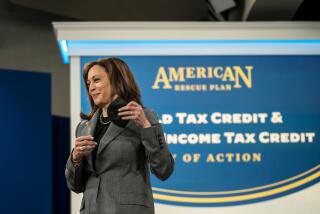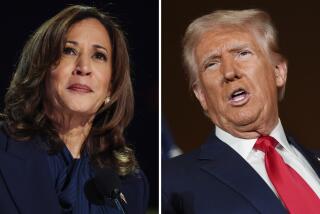Gore Favors Education Aid, End to ‘Marriage Penalty’
- Share via
MINNEAPOLIS — Vice President Al Gore staked his own claim in the brewing battle over tax cuts Friday, unveiling a plan that would expand tax-free education savings accounts.
In his one significant break with President Clinton’s tax cut proposal, Gore also said that he favors granting relief from the so-called marriage penalty. Clinton has criticized the quirk in the tax law that causes many spouses to pay more in taxes as a couple than if they filed as singles, but his plan does not address the inequity.
Gore, who is seeking to succeed Clinton in the White House, offered his tax policy ideas on the same day that the GOP-controlled Senate passed a $792-billion tax cut bill that the president has repeatedly vowed to veto. Gore has joined Clinton previously in denouncing the Republican plan. Friday, he denounced it as “reckless, unaffordable and fundamentally unfair.”
Gore’s speech on tax policy at the Minneapolis Community and Technical College represented his latest effort to move out of Clinton’s shadow and stamp his own imprint on major issues. Since May, Gore has offered an array of detailed position papers on topics ranging from crime and biomedical research to education and the role of “faith-based” organizations in combating social ills.
In Friday’s speech, Gore urged other candidates to “stand up and be counted” on where they stand on tax policy and to articulate “a considered judgment about America’s economic future.”
The comment was a clear swipe at both former Sen. Bill Bradley of New Jersey, who has attracted surprising financial support as Gore’s sole challenger for the Democratic nomination, and Texas Gov. George W. Bush, the front-runner in Republican ranks. Both Bradley and Bush have faced some criticism for offering more generalities than specifics on the campaign trail.
As for the timing of Gore’s speech, the vice president wanted to weigh in on the matter at a time when national attention is focused on it, his strategists said.
Gore said that a cornerstone of his tax policies would be to target benefits to the middle class. He estimated the cost of his overall package at $250 billion to $295 billion over 10 years--the same range as Clinton’s proposal. But some of the specifics in Gore’s plan would go beyond what Clinton has sought.
For instance, the president successfully pushed for creation of education savings accounts in which tax-free annual contributions are limited to $500 a year. Also, the money must be used by age 30.
Gore said that these provisions “simply don’t meet the needs of the Information Age.”
The vice president said that he would raise the maximum annual contributions to $2,500, funds that could be used for college or job training expenses over a lifetime.
And for families making less than $40,000 a year, Gore said, the government would match every $2 in contributions with $1 in tax relief.
“Here’s what that could mean: If your family saves $10 a week from the new child tax credit, we will match it with another $250 a year,” he said. “By the time your child turns 18, you will have a total of $28,000 for his or her college education--100% tax free.”
On health care, Gore noted that Clinton is seeking tax credits to help with the cost of long-term care but he said that should be “just the beginning” and that a “broader strategy” is needed.
Although he did not offer his own specifics, Gore said that he would “explore the use of the tax code” to help with the cost of medical insurance premiums.
On marriage penalty relief, Gore called for allowing joint filers who are married to get the same standard deduction now granted to two individual filers by raising the standard deduction by $1,400 for married couples who claim it.
“This will put $210 into the pockets of the typical middle-class family,” Gore said.
He also said that he would “extend and expand” tax breaks for research and development by the private sector.
More to Read
Get the L.A. Times Politics newsletter
Deeply reported insights into legislation, politics and policy from Sacramento, Washington and beyond. In your inbox twice per week.
You may occasionally receive promotional content from the Los Angeles Times.










